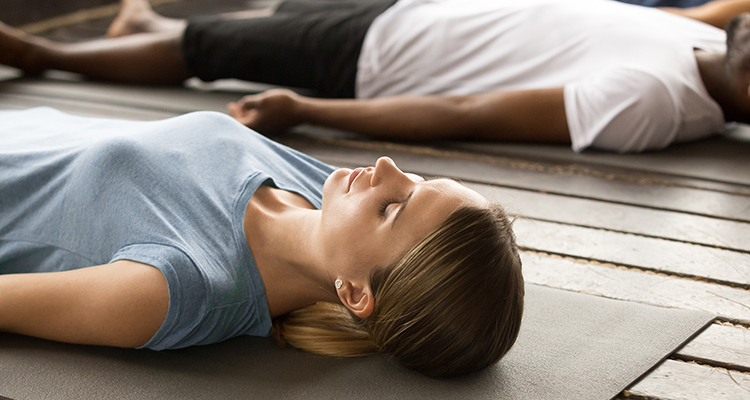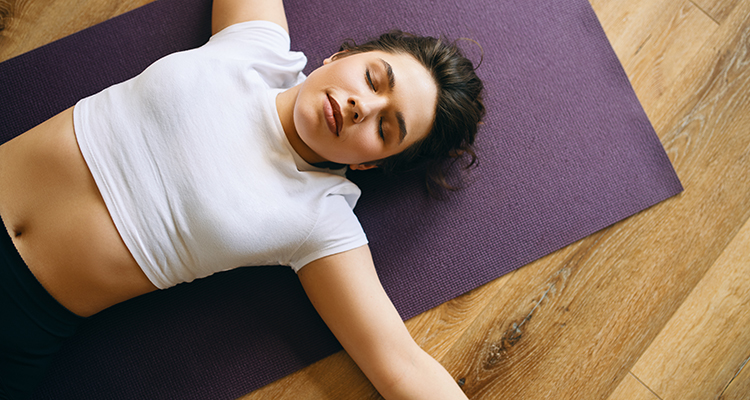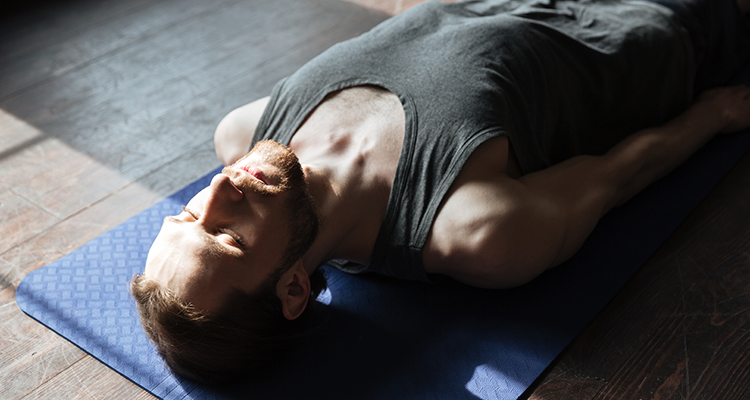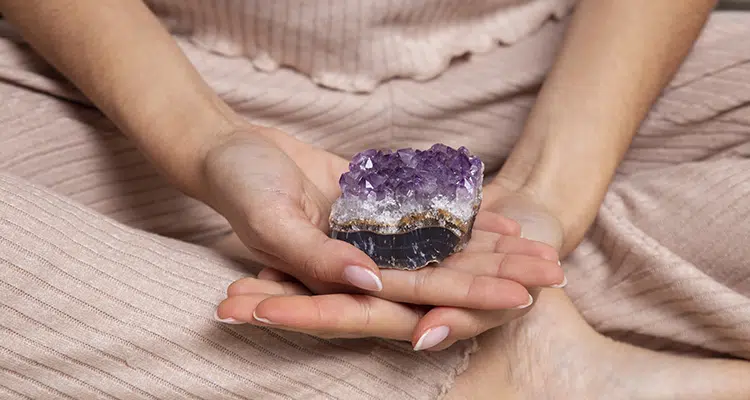The Benefits of Yoga Nidra for Sleep
The benefits of yoga are far-reaching. From increased flexibility and strength to reduced stress and anxiety, people have been using yoga to treat a myriad of ailments for centuries. Yoga Nidra, specifically, is said to improve sleep and help ease symptoms associated with insomnia. Even if you’ve never attempted yoga or don’t know the difference between a child’s pose and a downward-facing dog, you can still experience the benefits of this ancient practice.

Keep reading to learn more about Yoga Nidra for sleep and tips for incorporating this holistic practice into your daily and nightly routines.
Content
What is Yoga Nidra?
A form of guided meditation, Yoga Nidra is also referred to as “yogic sleep” or “effortless relaxation”. Yoga Nidra is usually performed in a reclined or lying position with a yoga instructor guiding the practice. This form of yoga is intended to draw your attention inward as you transition from a state of wakefulness and sleep. Here, your body should find a natural state of homeostasis (equilibrium). In this state of dreamless sleep, you can connect with your inner world and disconnect from the outside world. Your mind becomes calm and clear.

Signs that you’ve successfully achieved this balance include quiet, even breathing, an overwhelming sense of deep awareness, and a combination of conscious and unconscious thoughts. Other feelings and experiences include:
- A sense of wholeness
- Becoming aware of your true self
- Deep, expansive, and inclusive rest
- Entering a state of harmonious rest
It’s believed that once you enter this restful state, you can be healed, awakened, and restored to your deepest and most authentic self. While research about its effectiveness is still ongoing, believers swear by the practice of Yoga Nidra for sleep as the only way to enter a state of blissful awareness and deep, restorative rest.
The History of Yoga Nidra

Yoga Nidra was first practiced and documented in 700 BC with roots in the Sankhya philosophy. Over many centuries, people expanded upon and improved these practices, adding different methodologies from Patanjali and Buddha. These same practices were also explored later on as part of Advaita Vedanta, a philosophy that means “non-dual” or “not two”. Centuries later, these same practices were used by Kashmir Shaivism. Yoga Nidra encompasses many philosophies and forms of meditation, all focused on stillness, awareness, and discovering your inner light.
Yoga Nidra vs. Other Relaxation Techniques
If you’re familiar with other yoga practices and relaxation techniques, you may be wondering what makes Yoga Nidra different. Let’s take a closer look at some of the most popular forms of yoga and relaxation methods and how they compare to Yoga Nidra.

Shavasana
Shavasana is similar to Yoga Nidra in the sense that it’s a resting yoga pose that involves lying flat and motionless on your back. Shavasana is often done at the beginning or end of yoga practice when your mind and body are still and silent. Breathing is gentle, even, and effortless. “Shav” actually means “dead body” or “corpse”, which is another reason this pose is sometimes referred to as Corpse Pose. Being completely still is believed to bring deep relaxation to both the mind and body. As easy as it may seem to just lie on your back, some people struggle with Shavasana as it requires you to relinquish complete control of all your muscles and extremities and slow down both your thoughts and breathing.
Most yogis hold Shavasana for anywhere from 1 to 5 minutes, with some people actually falling asleep while in this pose. Students can either lie on their backs, belly, or side. An experienced yoga instructor will then guide students through a set of specific steps or actions including finding your “yogi breath”, setting an intention, and relaxing the muscles in your face. You may notice yourself slowly drifting to sleep or feeling a strange sense of being half asleep. The main difference is that Shavasana is a yoga pose, whereas Yoga Nidra is a state of consciousness that exists between being awake and asleep. While the proper practice of Shavasana can better help someone achieve Yoga Nidra, the two concepts are independent. Shavasana is not required to achieve Yoga Nidra and not everyone who practices Shavasana will experience Yoga Nidra.
Hypnosis
There are only a few similarities between Yoga Nidra for sleep and hypnosis. One is that both practices place your body into a deeply relaxed state where your subconscious mind is still very active. Both hypnosis and Yoga Nidra are used to influence your mind and thoughts, however, Yoga Nidra on its own is not recognized as a form of hypnosis. The intention of each practice is also very different, as are the steps involved.
Both hypnosis and Yoga Nidra for sleep start with a guided relaxation. The biggest difference is that during Yoga Nidra, you’re encouraged to stay awake as the practice forces many people into a state of blissful awareness. Your conscious mind is still aware and active, allowing you to take control of your thoughts and actions at any time. Hypnosis, on the other hand, suppresses the conscious mind, leaving most people with no recollection of what happened or what actions were taken. Yoga Nidra instructors help guide you to a deep state of awareness, whereas a hypnotist takes control of your conscious mind in an effort to explore the subconscious.
Meditation and Relaxation
People use the word “relax” to describe many different things from putting your feet up at the end of a hard day to enjoying a day of pampering at the spa. While these may seem like relaxation techniques, they’re actually mere diversions. By engaging in more pleasurable activities that don’t involve work, you’re diverting your attention to something more enjoyable.
True relaxation doesn’t occur unless your mind, body, and all five senses are at complete rest. This sometimes occurs during dreamless sleep and almost always occurs during deep sleep. Relaxation is crucial for maintaining proper health, both mentally and physically. During true relaxation, your body can repair itself, heal, and grow. Relaxation is the first step in Yoga Nidra. And although it plays an important role, it’s not the ultimate goal of this practice. Even though you enter a state of deep relaxation, your consciousness is still active. Here, you’re able to observe your thoughts, feelings, and breath.
Meditation is another common practice to help your mind and body relax, although it’s very different from Yoga Nidra. Most meditations are done in a seated position where you enter a waking state of consciousness. The purpose of meditation is to acknowledge thoughts as they enter and leave your mind. The ultimate goal of meditation is to enter the theta state. This is a state of sleep that you pass through on your way to deep sleep, also known as the delta state. Delta sleep is also where your body heals itself and is the ultimate goal of Yoga Nidra.
How Does Yoga Nidra Work?
Yoga Nidra interacts with the body’s autonomic nervous system which regulates body processes that occur without conscious effort. These include things like breathing, digestion, circulation, and heartbeat. The sympathetic and parasympathetic nervous systems are also part of the autonomic nervous system. Meditative practices help calm the body’s sympathetic nervous systems, including your body’s flight-or-fight response. It also activates the body’s pineal gland which releases the natural sleep hormone, melatonin.

Although every yoga instructor has their own unique way of teaching Yoga Nidra, many of the steps are the same. Here are the basic steps of Yoga Nidra and how to use them to improve your sleep.
1. Set an Intention
At the beginning of your practice, it’s important to connect with your heart’s deepest desires. Choose something as small as a daily goal or affirmation or something as big as a life-long goal. Ask yourself why you’re practicing Yoga Nidra and what your intentions are for the future. Visualize yourself reaching your goals and the sense of joy and accomplishment you’ll feel when you do. This intention should be at the forefront of your practice.
2. Identify Your Inner Resource
An inner resource while practicing Yoga Nidra is different for everyone. Identifying it involves tapping into a place within yourself where you feel safe and relaxed as you explore your yogi practice. Use memories and images to achieve a sense of well-being, belonging, and security. Only you can identify and pull from your inner resource during Yoga Nidra.
3. Scan Your Body
Next, you need to scan your entire body from head to toe. During this process, it’s important to focus on the areas where you feel tension, stress, and other noticeable sensations. Use your senses like a microscope to listen, explore, and welcome all aspects of your body and breath. As you identify tension, you can work to release it and begin to relax both your body and mind.
4. Focus on Your Breathing
Breathing is also an important part of Yoga Nidra. Pay close attention to how the air is entering and exiting your body. Notice how it comes into your nose and fills your lungs fully, causing your belly to rise and fall. By focusing on every step of the breathing process, you can start to slow it down and control it as you enter a deeper state of relaxation.
5. Accept Your Thoughts and Feelings
The more relaxed you become, the more open your mind is to accepting and welcoming different thoughts, emotions, and beliefs. Sometimes, unexpected feelings start to emerge. For example, suppressed memories or issues that you’ve been avoiding may quickly enter the forefront of your mind. Overwhelming emotions, fears, and other repressed feelings may also surface.
As you enter a relaxed, neutral state of being, you’re better able to welcome, accept, and process these feelings, thoughts, and beliefs. You may even be able to sort through difficult memories or traumatic events, arriving at a more understanding place. Yoga Nidra utilizes classic yogi techniques to achieve this like spacious awareness, trust, and reflecting on opposites. It’s important not to judge yourself or the feelings that emerge. Instead, accept them and move on. Ignoring these negative emotions will only make things worse. If you notice sparks of joy or moments of bliss, embrace and relish them.
6. Observe Your True Self
Now it’s time to explore your consciousness and true self. Be honest about your personality, flaws, strengths, and any other true emotions that shine through. Think of yourself as an unbiased observer. This is the best way to honestly view your true self and tap into your deepest desires. Ask yourself questions like, “Who am I?” and “Am I aware of my true self?”. The practice of Yoga Nidra lets you tap into your true self and adopt a mantra of being open, unbounded, and expansive, which for many, is the ultimate form of liberation.
7. Reflect on Your Practice
Don’t rush out of your practice. Exit your relaxed state slowly by bringing movement to your fingers and toes and awareness back to your breath. After you’ve completed your Yoga Nidra practice, observe how you feel. What techniques did you use to successfully tap into your inner self and achieve blissful awareness? Now, think about how you can bring this same peace, stillness, and joy to your daily life. Slowly transition into a waking state of mind and remember what methods were effective for achieving complete relaxation. In time, you can apply these same practices to achieve quality sleep.
The Benefits of Yoga Nidra
A deeper understanding of your true self and the ability to transition between a state of sleep and wakefulness are just a few of the many benefits of Yoga Nidra. If you’re thinking about adding this practice to your daily regime, here are a few additional benefits to consider.

Reduced Stress and Anxiety
Stress and anxiety are two leading causes of insomnia. A shocking 77% of people experience stress that impacts their physical health with another 73% claiming stress and anxiety affect their mental health and well-being. Lack of sleep can also have a monumental impact on both of these factors.
By reducing stress levels through Yoga Nidra, you can improve your overall quality of life. One study showed that this form of yoga is more effective than meditation for reducing both physiological and cognitive symptoms of anxiety. When you become stressed, your body produces higher levels of cortisol and epinephrine which are stress hormones. This can lead to heart disease, excess fatigue, stroke, inflammation, chronic pain, and certain sleep disorders.
Slower Brain Waves
During Yoga Nidra, your brain enters a deep state of sleep, producing theta and delta waves. Theta brain waves range from 4 to 7 hertz, while delta waves range from 1 to 3 hertz. Although you’re still conscious, your brain waves slow down to the equivalent of peaceful sleep. A theta state is synonymous with the REM sleep cycle and is also utilized in some forms of hypnosis. Some people also experience inspiration and spiritualization while in a theta state as their brain becomes active below the level of the conscious mind.
Delta waves are the slowest type of brain wave and often occur during dreamless sleep. It’s in a delta state where your body heals, recovers, and restores itself.
Ease Chronic Pain
Chronic pain affects over 60 million people worldwide. Persistent pain and discomfort can lead to a myriad of other issues including a dependency on prescription medications, depression, health complications, and insomnia. In fact, as much as 80% of chronic pain sufferers also report sleep troubles. The human body is naturally self-healing. Yoga Nidra helps facilitate this process by giving it the time and space to do so. The goal of Yoga Nidra is to transition you from a state of doing to a state of being, where your body can release tension and heal itself. Certain studies suggest that Yoga Nidra is an effective tool for treating and reducing chronic pain by reducing inflammation and improving immune function.
Reduce the Risk of Serious Illness
Stress, lack of sleep, and chronic pain can all put you at greater risk of developing even more serious medical conditions like heart disease, diabetes, and even cancer. Yoga Nidra may help reduce your risk of experiencing potentially life-threatening ailments. According to an article posted in the Indian Journal of Physiology and Pharmacology, Yoga Nidra may help control blood glucose levels and, therefore, reduce diabetes symptoms.
Heal Trauma
Past trauma can make it difficult to heal, rest, and move forward. It can also trigger anxiety and sleep disturbances. Yoga Nidra puts you in a state of healing, reflection, and clarity. As previously mentioned, repressed memories and emotions often surface during your practice. It may become easier to navigate and face difficult emotions you were unable to deal with or face before. The Department of Defense reported that soldiers suffering from PTSD following war used Yoga Nidra weekly to help facilitate healing.
Ease Insomnia Symptoms
All of the above-mentioned issues can cause both acute and chronic insomnia. Sleep is necessary for everyday functioning and both mental and physical well-being. By treating these underlying conditions, Yoga Nidra can also improve sleep and help ease insomnia symptoms. Certain studies suggest that just 45 minutes of Yoga Nidra is equivalent to 3 hours of sleep. Yoga Nidra teaches you to slow your breathing and racing thoughts while entering a state of complete relaxation while facilitating quality sleep. You can even use Yoga Nidra for sleep to help compensate for a restless night. Practice Yoga Nidra before bed or even midday as a way to prepare both your mind and body for restful sleep.
Who Can Use and Benefit From Yoga Nidra for Sleep?

The short answer is, anyone! With enough practice, anyone with sleep troubles can benefit from Yoga Nidra for sleep. Even if you’re not currently experiencing insomnia symptoms, Yoga Nidra can help those with extreme stress or anxiety learn to “let go”. If you’ve dabbled in meditation before or are in desperate need of a holistic way to treat insomnia, depression, or other health conditions, Yoga Nidra can help. Just keep in mind that you won’t notice results overnight (no pun intended) and it will take practice to tap into your conscious mind and learn to effortlessly move from a state of wakefulness to a state of complete awareness and relaxation. It may take months or even years to perfect Yoga Nidra, so be patient and start slow.
Tips for Getting Started with Yoga Nidra
Are you interested in using Yoga Nidra for sleep, but aren’t sure where to start? Here are a few tips to help guide your way.

Practice Makes Perfect
Speaking of practice, yoga is considered a practice for a reason. It takes time to learn the ins and outs of this ancient past-time and experience the full benefits. In a fast-paced world where people are accustomed to instant gratification and immediate results, it can be difficult to slow down long enough to master the relaxing techniques and mind control used in Yoga Nidra.
Understand that it will take time for you to master using Yoga Nidra for sleep. And you may never fully perfect your practice. But with enough time, patience, and practice, you can slowly learn to incorporate these techniques and methods into your daily life as a way to reduce stress, improve your health, and overcome insomnia symptoms.
Find a Qualified Instructor
One of the easiest ways to get started with Yoga Nidra is to find a qualified instructor to help walk you through the process and guide your practice. Yoga instructors are highly trained in guiding a class and offering useful suggestions for clearing your mind, controlling your breathing, and entering a deep state of relaxation. Find out if a local yoga studio in your area offers Yoga Nidra for sleep. If not, your doctor or sleep specialist may have a suggestion or even utilize some of the same principles in their own treatment plans.
Become the Master of Your Own Destiny
What if we told you that the key to achieving a quality night’s sleep was inside you all along? While most insomnia sufferers will tell you that getting a good night’s sleep isn’t as easy as that, Yoga Nidra for sleep may help improve your outlook and ability to fall and stay asleep. This ancient practice helps you regain control over your thoughts and the mind-body connection. Although sleeping pills, medications, and supplements do offer their own benefits, both yoga and CBTi are effective, holistic ways to overcome common sleep disorders, including insomnia.

Somnus Therapy utilizes a combination of CBTi methods to help you identify, understand, and address the root cause of your sleep issues. Our convenient online sleep therapy program lets you complete each step of the process at your own pace and in the comfort of your own home. Click here to start your journey.
















